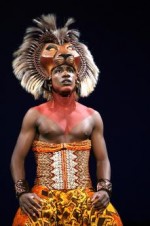The ‘Circle of Life’ Continues

After debuting at the Tampa Bay Performing Arts Center last week, The Lion King proved it still reigns supreme among Disney favorites. This year marks the play’s 10th anniversary. Winner of 70 awards, including Best Musical, Best Scenic Design and Best Costume Design, being performed in 63 cities in 11 countries, and entertaining more than 45 million audience members, The Lion King is a spectacular show.
As the lights faded and the “Circle of Life” began, African chants performed by Rafiki and two other cast members engaged the audience. When Pride Rock appeared onstage, puppets resembling some of Africa’s iconic animals prowled the aisles, much to the delight of the audience. Life-size elephants, rhinos, zebras, antelope and flocks of wild birds crept to the stage as children grinned from ear to ear and stared wide-eyed at the spectacle. The theater was filled with applause before the first musical number was over.
Director Julie Taymor designed the show with both traditional Disney characters and African culture in mind. While some puppets still resemble their familiar counterparts from the Disney film, characters such as Scar, Mufasa and Simba bore intricately designed African mobile masks.
“Audience members have an important role in the show as well,” said actor Ben Lipitz, who starred as Pumba. “It’s the use of their imagination that brings our character to life. (The actors) along with the audience’s imagination helps the audience to believe in the character.”
A special form of puppetry known as Bunraku is used throughout the performance. Bunraku puppets are large and are controlled by one or more people. Actors must maneuver their characters using a number of controls and devices underneath the puppet to bring them to life, like the characters of Pumba and Timon in the Tampa performance.
“Instead of forcing the actors to accommodate the puppetry, the puppets were built around the actors, emphasizing their movements instead of hindering them,” said USF sophomore and theater major Savannah Thomas, who attended the show.
Both actors and theatergoers agree that the Carol Morsani Hall’s design allowed for a greater connection between viewers and performers.
“The intimacy of the venue allowed the audience to feel like they were a part of the show – as if I was a part of the ‘Circle of Life,'” said Jackie Deppner, a junior in theater performance at USF.
The intimacy also makes the job of the actors that much easier.
“The fact that you can see all of the audience makes for a very effective performance,” said Morgan Spector, a standby for Scar.
This was particularly evident during a scene in which wildebeests stampeded across the stage. It began as a scroll of wildebeests painted on canvas, but as the animals grew larger and closer to the audience, actors with large masks appeared on stage running in place. The illusion made the stampede appear to continue for miles.
The Lion King appeals to people of all ages. Children are entertained as they watch the characters they love tell the familiar story and sing the verses of “Hakuna Matata.” Adults see “The Lion King” they knew as a child in a new light.
“(You) wouldn’t believe how many times I’ve looked into the audience and seen the adults as wide-eyed as the kids,” said dancer and ensemble member Nicole Alvarez.
For some people, the show seems to change as they see it at different stages in their lives.
“The interesting thing about this show is, now that it’s been going on for 10 years, people come back over and over again and it has an incredibly different meaning from when they were younger,” said Lipitz. “It’s a timeless show that generations keep coming back to.”






